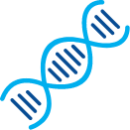Beta-thalassemia
About beta-thalassemia
Beta-thalassemia is a rare blood disorder caused by genetic mutations in the HBB gene, which are associated with the absence or reduced production of beta-globin – one of the two proteins that comprise adult hemoglobin. This results in an abnormally low level of hemoglobin as well as an excess of alpha-globin chains, causing destruction of red blood cells.
Beta-thalassemia has been clinically characterized into three forms, depending on disease severity: major, intermedia and minor. The most severe form is generally diagnosed shortly after birth and is characterized by life-threatening anemia. Pediatric patients do not grow and gain weight at the typical rates, and often have liver, heart and bone problems. Many patients with beta-thalassemia major require chronic blood transfusions due to severe anemia that results from low hemoglobin levels. Beta-thalassemia intermedia is a less severe form of the disease that results in mild to moderate anemia. These patients sometimes require blood transfusions depending on the severity of their symptoms. Patients with beta-thalassemia minor suffer from very mild anemia and generally do not require treatment.
The only potentially curative therapy for beta-thalassemia is allogeneic hematopoietic stem cell transplant, which is associated with risks of complications, including mortality, and is limited to patients with a suitable donor.
Facts about beta-thalassemia
Incidence
- It is estimated that 40,000 babies are born worldwide with beta-thalassemia per year, of whom 25,000 require blood transfusions.
- The most severe form of beta-thalassemia, beta-thalassemia major, is typically diagnosed shortly after birth.
Genetics
